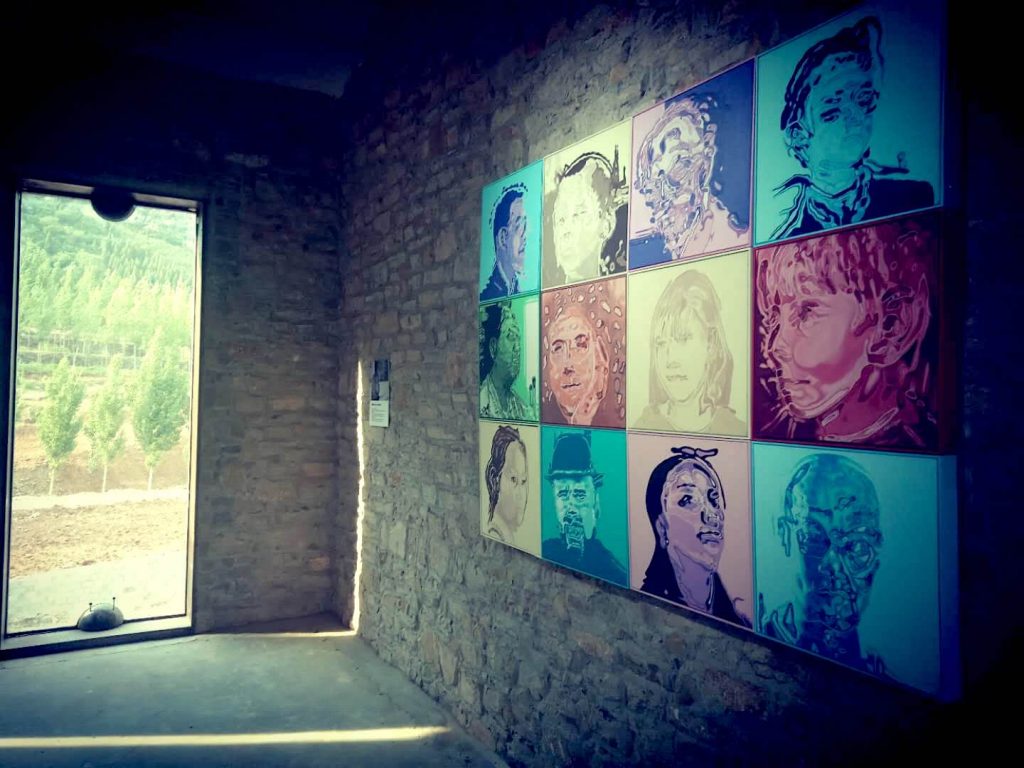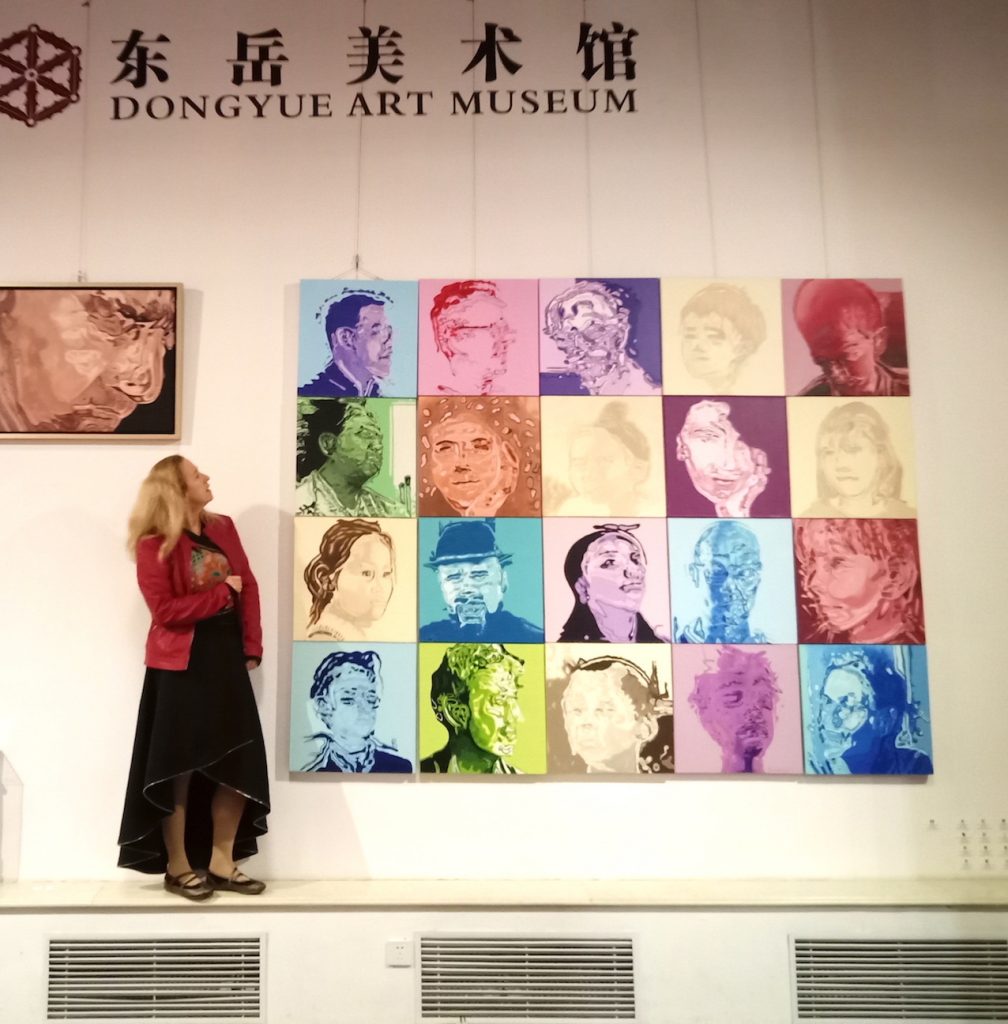I began the portrait project in 2009 when I lived in Prague and have slowly continued this work throughout my years in China. The subjects range in age from 6 months to 100 years young. Through out the year of 2019 I posted a portrait every week on my webpage . This page will look at the different exhibitions in 2019 where the portraits were installed. Also included in this page is a curatorial statement on my portrait series by renowned curator Huang Du.



作为一位在当代艺术语境下具有“破坏”与“重建”意识的艺术家,瑞莲(Niamh Cunningham)完成的“漂泊岩石”(The Wandering Rocks)系列由22张小幅 肖像画组成。
她深受《尤利西斯》第十章丰富而奇异的文学叙事的启发,,描绘了与自己相关的生活在北京和爱尔兰的人的肖像(家人、朋友、学生、艺术家和策展人等),
他们被重新塑造,其形象被比喻或扮演成不同的漂泊岩石。
可以发现画家利用类似于照片组合的方法,通过一种现实与虚拟元素的组合来创造出一种带有水波纹式的幻像语言,以引发观者
的惊奇之感。她的绘画蕴含了另一种解释世界的方法,图像仿佛承担着现实调查的文件,也是生活世界的存在方式。
与其说她偏爱表现肖像,不如说是表达了对图像拥有何种被感知的思考,以及如何面对认知的习惯性。事实上,每件作品都积淀着
艺术家的生活经验,由绘画的笔触、材料和由预先设定的题目引发出的一种连贯性。
她将绘画的艺术语言和今天的生活经验相融合,表现出富有个性的视觉语言。这类肖像画系列颇有融超经验(trans-experience)
的特征,其动态-碎片-重影承载着时间、空间、身份和记忆。 “尤利西斯”第十章,描写奥德修斯在回伊萨卡时没有采取返回的路
线。
切尔斯告诉他,这些漂流的岩石会造成大的破坏,他不应该走这条路。在“尤利西斯”中,该章节呈现了都柏林平日抛掷残骸,
分散而杂乱的面孔,形形色色人物总是在走动着穿越都柏林。这一章中能在某处找到大部分的人物。白天城市的背景是总督带领骑
士队伍正行进在去医院筹款的街道途中。这种异样的绘画语言并不只是所谓形式上的突破,而是它的编造带来的是对绘画主观给以
碎片化处理,并内化于心的形而上破解,实现图像与记忆交合的感知力,从而建立了新的形象叙事,达到对肖像画的重新界定。
与此同时,她在这样的创作中力图改造绘画的路径,截断了肖像画过于追求经典化,而是给绘画大胆注入了类似摄影的要素,
使切片化形象瞬间建立起主体和语言经验的连接。
她运用另类绘画的方法解构已存在的诸多艺术创作规则,建立起图像和文学平行的两个世界中真实存在的交合点。
As an artist with an awareness of “destruction” and “reconstruction” in
the context of contemporary art, Niamh Cunningham has created the “Wandering
Rocks” a series which consists of 22 small portrait paintings, inspired by the
rich and curious literary narrative in the eponymous Chapter 10 of ‘Ulysses’.
She paints these portraits of people living in Beijing and Ireland (families,
friends, students, artists, curators, etc.) in which they are reconfigured,
their images are transformed, reshaped metaphorically into different
‘wandering’ rocks. The artist uses a method whereby she layers photographic
images to create an ethereal effect like water ripples, a way of combining real
and virtual elements to provoke a sense of surprise in the viewer.
Her paintings describe another way of interpreting the world. The images
bear testimony to a real investigation into the way in which the living world
actually exists. Rather than saying that she simply likes painting portraits,
it is more accurate to describe these works as perceived thinking about the
image itself and how to engage with cognizance which is habitual.
In fact, each piece of work is a combination of the artist’s lived
experience, her brush painting and materiality bound together using
technological pre-sets. She combines the artistic language of painting with
today’s lived experience in order to create a unique and personal visual
language.
This series of portraits embodies a range of experiences in its dynamic
fragmentation, insubstantial images which evoke time, space, identity and
memory. This fastidious way of painting is not merely a type of formal
innovation, the creative process itself causes an actual disintegration of the
painting’s subjectivity and internalizes this metaphysical rupture. In bringing
together the perception of image and that of memory, a new image narrative
which redefines the portrait, is created.
At the same time, the artist has endeavoured to transform the act of painting, distancing herself from the pursuit of the classical, while at the same time incorporating photographic elements. So, the cropped image instantly establishes the connection between the subject and the experience/awareness of language. She uses alternative painting methods to deconstruct the existing rules of artistic creation and establishes a real intersection of two creative worlds: the visual and the literary.
Huang Du Feb 2019
